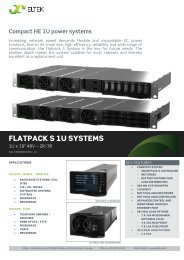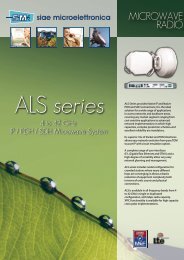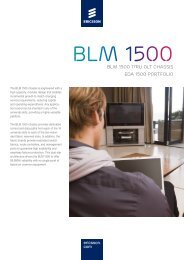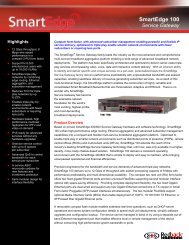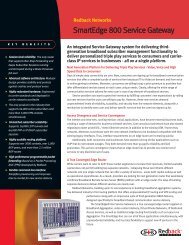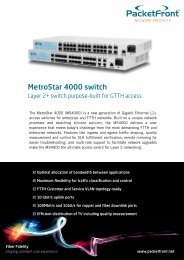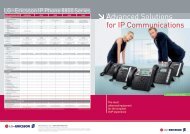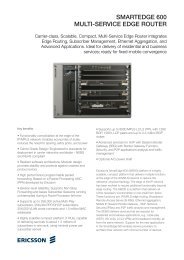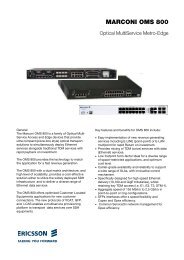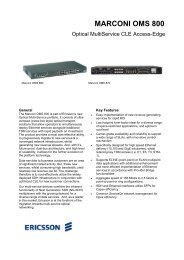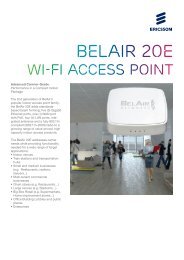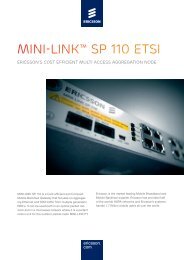MINI-LINK SP 310
MINI-LINK SP 310
MINI-LINK SP 310
You also want an ePaper? Increase the reach of your titles
YUMPU automatically turns print PDFs into web optimized ePapers that Google loves.
<strong>MINI</strong>-<strong>LINK</strong> <strong>SP</strong> <strong>310</strong><br />
Multi-Access Aggregation Platform<br />
<strong>MINI</strong>-<strong>LINK</strong> <strong>SP</strong> is a 120 Gbps Carrier Ethernet<br />
platform with standard 10-Gigabit Ethernet<br />
ports for the converged access and aggregation<br />
applications. It is available with industryleading<br />
circuit emulation service, which is<br />
designed to accelerate circuit migration to<br />
all-IP networks.
<strong>MINI</strong>-<strong>LINK</strong> <strong>SP</strong> <strong>310</strong><br />
Key benefits<br />
• High-Capacity Carrier Ethernet platform in a compact<br />
1.5 RU.<br />
• Designed for wire-speed and non-blocking 120 Gbps<br />
(half-duplex) switching performance.<br />
• Lower cost alternative to the traditional SONET/SDH<br />
metro ring providing resilient backhaul of voice and<br />
mission critical data services. G.8032 (Ethernet Ring<br />
Protection) adds 50-ms path protection and E-LINE/<br />
E-LAN service restoration.<br />
• Highly-extensible platform with 20 standard Gigabit<br />
Ethernet ports, two standard 10-Gigabit Ethernet ports<br />
and two multi-access expansion slots.<br />
• Two optional multi-access modules include:<br />
- Circuit Emulation Service (CES) with eight discrete<br />
T1/E1 ports.<br />
- One port 10-Gigabit Ethernet<br />
• When equiped with the optional CES module, <strong>MINI</strong>-<br />
<strong>LINK</strong> <strong>SP</strong> maintains the proven benefits of TDM<br />
Services:<br />
- Synchronous and deterministic transmission<br />
- Fast protection and restoration of service<br />
- Service performance assurance<br />
- Superior Operation Administration and<br />
Maintenance (OAM)<br />
Key features<br />
• All Gigabit Ethernet and 10-Gigabit Ethernet ports<br />
support standard-based provider bridging (802.1ad)<br />
and MPLS-TP for scalable Ethernet transport.<br />
• Purpose-built with all industrial grade components<br />
designed to support extreme temperature applications.<br />
• Support for redundant hot swappable, redundant<br />
power supply and field replaceable fan tray.<br />
• NEBS and RoHS compliant<br />
• Ethernet transport, resiliency and service compliance:<br />
- Provider bridging (802.1ad)<br />
- MPLS-TP<br />
- G.8032v2 Ethernet ring protection<br />
- MEF 9, 14 and 20 (UNI Type 2.1) certified<br />
• Ethernet performance management and assurance:<br />
- 802.3ah OAM and 802.1ag CFM<br />
- Y.1731<br />
- SNMPv2/v3<br />
• Ethernet timing:<br />
- IEEE 1588v2<br />
- Sync Ethernet<br />
• TDM service:<br />
- T1/E1 Circuit Emulation Service<br />
<strong>MINI</strong>-<strong>LINK</strong> <strong>SP</strong> series of multi-access aggregation<br />
platforms<br />
Globally, carrier networks are under tremendous pressure<br />
to expand the bandwidth capacity at the access and<br />
aggregation networks. The advancements of mobile<br />
and enterprise devices, offering high-definition video<br />
and robust real-time applications, have exposed the<br />
architectural limitations of legacy networks. Even with the<br />
recent retrofits that add Ethernet capabilities, many of<br />
these networks are running at near maximum capacity.<br />
Well-proven in core and edge networks, Carrier Ethernet<br />
is the natural and the best replacement technology.<br />
However, access networks require a different class of<br />
architecture; a new class of Carrier Ethernet architecture<br />
that serves dual roles - to provide a seamless migration<br />
path from TDM circuit to Ethernet, and to lay an ultrascalable<br />
foundation for next generation networks.<br />
The <strong>MINI</strong>-<strong>LINK</strong> <strong>SP</strong> 110 is the most cost-effective and<br />
compact model. At 1 RU high, the <strong>MINI</strong>-<strong>LINK</strong> <strong>SP</strong> 110 is<br />
suitable for application where space is limited, such as,<br />
the very edge of the networks.<br />
The <strong>MINI</strong>-<strong>LINK</strong> <strong>SP</strong> 210 and <strong>310</strong> share the same 1.5 RU<br />
chassis. Designed with industrial grade chipsets, both<br />
platforms are ideal for extreme temperature applications,<br />
such as cell site and building aggregations.<br />
<strong>MINI</strong>-<strong>LINK</strong><br />
<strong>SP</strong> 210<br />
<strong>MINI</strong>-<strong>LINK</strong><br />
<strong>SP</strong> 110<br />
TDM/<br />
Ethernet<br />
Backhaul<br />
IWF<br />
TDM /Ethernet<br />
Local Loop<br />
<strong>MINI</strong>-<strong>LINK</strong><br />
<strong>SP</strong> <strong>310</strong><br />
IWF<br />
<strong>MINI</strong>-<strong>LINK</strong><br />
<strong>SP</strong> 210<br />
G.8032<br />
10-GigE Ring<br />
Dual-Homed GigE<br />
<strong>SP</strong>O 1400<br />
Packet<br />
Switched<br />
Networks<br />
<strong>MINI</strong>-<strong>LINK</strong> <strong>SP</strong> 210 & 20 Commercial Presentation | Commercial in Confidence| © Ericsson AB 2010 | July 2010 | Page 1<br />
IWF<br />
SmartEdge<br />
with CES<br />
BSC and<br />
RNC<br />
OC-3/ STM-1<br />
GigE<br />
Master TOD and<br />
Frequency Clock<br />
<strong>MINI</strong>-<strong>LINK</strong> <strong>SP</strong> <strong>310</strong> for the converged access and<br />
aggregation<br />
Both the <strong>MINI</strong>-<strong>LINK</strong> <strong>SP</strong> 210 and <strong>310</strong> support industrylargest<br />
switching capacities in its class. The <strong>MINI</strong>-<strong>LINK</strong><br />
<strong>SP</strong> 210 supports 36 Gbps switching capacity and the<br />
<strong>MINI</strong>-<strong>LINK</strong> <strong>SP</strong> <strong>310</strong> can handle a massive 120 Gbps. The<br />
large switching capacity ensures that the platforms have<br />
enough future headroom to handle new innovative IP<br />
services and also protects carrier’s investments.
The standard <strong>MINI</strong>-<strong>LINK</strong> <strong>SP</strong> <strong>310</strong> comes with 20-Gigabit<br />
Ethernet ports for high-density cell-site and building<br />
aggregation. Additionally, two standard 10-Gigabit ports<br />
can be configured as redundant rings similar to SONET/<br />
SDH in the metro ring.<br />
G.8032 adds 50-ms of path protection and enables<br />
SONET/SDH-like restorations for E-LINE and E-LAN<br />
services.<br />
When combined with the TDM expansion module and<br />
Circuit Emulation Service, G.8032 enables <strong>MINI</strong>-<strong>LINK</strong><br />
<strong>SP</strong> <strong>310</strong> to backhaul voice and other mission critical<br />
data services. The ample backhaul capacity effectively<br />
reduces network upgrade churns and lowers operational<br />
costs.<br />
Ericsson Circuit Emulation Service<br />
Additional management modules include ServiceON ESA<br />
and NetOp Network Service Manager (NSM), which give<br />
network managers the power to easily provision end-toend<br />
VPN services, automate provisioning workflows and<br />
monitor end-to-end circuit with point and click simplicity.<br />
ServiceON EM/ ESA is a well-proven management<br />
system for the transport-oriented networks consisting of<br />
<strong>MINI</strong>-<strong>LINK</strong> microware radios, and OMS/<strong>SP</strong>O platforms<br />
for PDH/ SDH transport.<br />
For the Ethernet packet switched networks consisting<br />
of SmartEdge, SM and <strong>MINI</strong>-<strong>LINK</strong> <strong>SP</strong>, Ericsson offers<br />
NetOp. NetOp EMS/NSM is a powerful management<br />
system purpose-built for Ethernet and IP network<br />
management. With NetOp NSM, a network operator can<br />
easily provision any type of IP circuits including, L2 VLL/<br />
VPLS, L3 BGP VPN and even site-to-site IPSec VPN with<br />
point and click simplicity.<br />
integrations with eric<br />
network management<br />
Transport Oriented Networks<br />
Transport-Oriented Networks<br />
Mini-Link<br />
CN, TN, PT<br />
<strong>MINI</strong>-<strong>LINK</strong><br />
<strong>SP</strong><br />
Assurance<br />
Circuit<br />
ntegrations with ericsson<br />
and Fault<br />
Provisioning<br />
Mgmt<br />
CES<br />
etwork management systems<br />
Transport Oriented Networks<br />
Mini-Link<br />
CN, TN, PT<br />
<strong>MINI</strong>-<strong>LINK</strong><br />
<strong>SP</strong><br />
Performance<br />
Resiliency<br />
Interworking<br />
(IWF)<br />
OMS/ <strong>SP</strong>O<br />
1400<br />
Unified<br />
Timing<br />
and Sync<br />
MHL<br />
3000<br />
Ethernet Switched Networks<br />
<strong>MINI</strong>-<strong>LINK</strong><br />
<strong>SP</strong><br />
SM<br />
OMS/ <strong>SP</strong>O<br />
1400<br />
SmartEdge<br />
MHL<br />
3000<br />
IP/ Ethernet Switched Networks<br />
<strong>MINI</strong>-<strong>LINK</strong> <strong>SP</strong> series supports the most advanced and<br />
industry-leading implementation of Circuit Emulation<br />
Services (CES) based on the latest CESoPSN and SAToP<br />
standards. <strong>MINI</strong>-<strong>LINK</strong> <strong>SP</strong>’s CES goes beyond the simple<br />
transports of TDM services over Ethernet pseudowires.<br />
To complement the TDM timings, Ericsson integrates the<br />
1588v2 and SyncE for flexible timing options. Carriers<br />
can also enforce Service Level Agreements (SLAs)<br />
through the Y.1731. The Y.1731 provides embedded<br />
performance assurance by monitoring frame loss, jitter<br />
and latency, allowing a fine-grain, accurate monitoring of<br />
SLAs.<br />
<strong>MINI</strong>-<strong>LINK</strong> <strong>SP</strong> 210 & 20 Commercial Presentation | Commercial in Confidence| © Ericsson AB 2<br />
Standards-based OAM and Network Management<br />
Systems<br />
<strong>MINI</strong>-<strong>LINK</strong> <strong>SP</strong> 110, 210 and <strong>310</strong> are tightly integrated<br />
into the ServiceON Element Manager (EM) and NetOp<br />
Element Management System (EMS). Both management<br />
systems provide intuitive GUI interfaces for fast element<br />
configurations and full FCAPS monitoring.<br />
<strong>MINI</strong>-<strong>LINK</strong> <strong>SP</strong> 210 & 20 Commercial Presentation | Commercial in Confidence| © Ericsson AB 2010 | July 2010 | Page 1
Technical Specifications<br />
<strong>MINI</strong>-<strong>LINK</strong> <strong>SP</strong> <strong>310</strong><br />
CONFIGURATIONS<br />
• Physical Dimension: Height 1.5 RU, Depth<br />
250mm, Width 446mm<br />
• 2 slots for expansion modules<br />
• Air flow: Right to Left<br />
• Switching capacity: 120 Gbps (Half-Duplex)<br />
• Weight: 8 kg<br />
• USB port for file upload and download<br />
• One RJ-45 console port<br />
• One 10/100/1000 Base-T Ethernet for Out-of-<br />
Band Management<br />
• Two Sync ports for 1pps + TOD<br />
• 20 GE SFP ports<br />
• 8 out of the 20 GE ports are combo SFP or<br />
10/100/1000BaseT ports<br />
• 2 x 10GE XFP ports<br />
OPTIONAL EXPANSION MODULE<br />
• 8 port T1/E1 Circuit Emulation module<br />
• 16 port T1/E1 ATM IMA & ML-PPP module<br />
• 1 port 10-Gigabit Ethernet module<br />
OPERATING ENVIRONMENT<br />
• Operating Temperature: -40 - 65°C<br />
• Humidity: 0 - 95% Non-condensing<br />
• Power: -48 VDC; 110 – 240VAC<br />
• NEBS Level III, UL 60 950-1, GR-63 Core,<br />
GR-1089 Core<br />
• ETSI EN 300 386, FCC Part 15<br />
• RoHS-6<br />
POWER CONSUMPTION<br />
• 150 Watts<br />
MULTICAST<br />
• IGMP Snooping, IGMP Proxy<br />
ROUTING PROTOCOLS<br />
• O<strong>SP</strong>Fv2<br />
• IPv4<br />
MPLS RELATED PROTOCOLS<br />
• PWE3<br />
• Static L<strong>SP</strong><br />
• MPLS-TP<br />
LAYER 2 PROTOCOLS<br />
• 802.1Q Virtual LAN<br />
• 802.1ad Provider Bridging<br />
• ITU G.8032v2 Ethernet Ring Protection<br />
ETHERNET SERVICES (MEF)<br />
• E-Line<br />
• E-LAN<br />
T1/ E1 CIRCUIT EMULATION SERVICE<br />
• SAToP (Structure Agnostic TDM over Packet);<br />
IETF RFC 4553 & MEF 8<br />
• CESoPSN (Circuit Emulation Service over<br />
Packet Switched Network); IETF RFC 5086 &<br />
MEF 8<br />
NETWORK MANAGEMENT<br />
• RADIUS<br />
• SNMP v2/3<br />
• Syslog<br />
• RMON<br />
• TACACS+<br />
• Supported by NetOp EMS/ NSM R6.3<br />
• Supported by ServiceON EM R 10.2 and ESA<br />
R 10.3<br />
QOS<br />
• MEF QoS (MEF 10.1)<br />
• Policing from 64kbps to 10Gbps<br />
• 802.1p<br />
• DSCP<br />
• MPLS EXP<br />
• WRED<br />
• ACL<br />
OAM<br />
• 802.1ag Fault Management<br />
• Y.1731 Performance Management<br />
• 802.3ah Link OAM<br />
• BFD<br />
PERFORMANCE<br />
• Linerate from 64 byte to 9600 byte MTU<br />
TIMING AND SYNCHRONIZATION<br />
• IEEE 1588 V2 OC, TC and BC<br />
• Synchronous Ethernet<br />
Ericsson<br />
www.ericsson.com<br />
© Ericsson AB 2010<br />
2/287 01-FGC 101 1045 Rev B 02-07-2010



